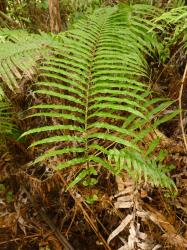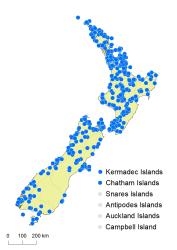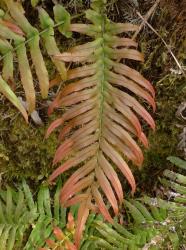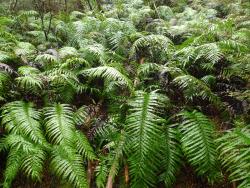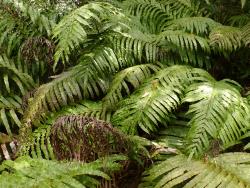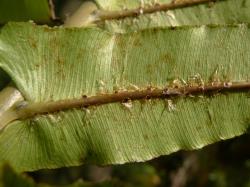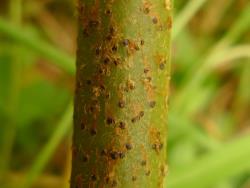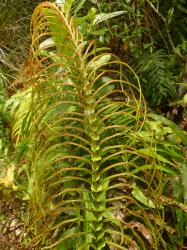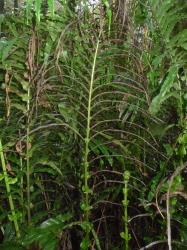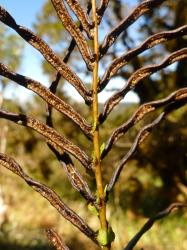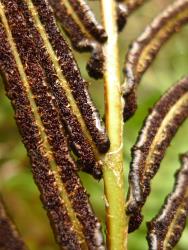- ≡ Parablechnum novae-zelandiae (T.C.Chambers & P.A.Farrant) Gasper & Salino in Gasper et al., Phytotaxa 275: 203 (2016)
- = Stegania procera var. stipulosa A.Rich., Essai Fl. Nouv.-Zél., 86, t. 13 (1832)
- = Lomaria procera var. β Hook., Icon. Pl. 5, t. 177–178 [427–478] (1841)
- = Parablechnum procerum var. acuminatum C.Presl, Epimel. Bot. 109 (1851) – as acuminata
- ≡ Blechnum capense var. acuminatum (C.Presl) Domin, Biblioth. Bot. 20(85): 115 (1913)
- = Lomaria procera var. flagelliformis Szyszyl. in Wawra von Fernsee, Itin. Princ. S. Coburgi 2, 121 (1888)
Rhizomes short-creeping, up to 100 m long (in herbarium material), bearing scales. Rhizome scales narrowly ovate, 5–21 mm long, 1–2 mm wide, chestnut-brown, concolorous or occasionally slightly bicolorous with paler margins. Fronds strongly dimorphic; fertile and sterile fronds with similar habit, arching upwards or outwards; sterile fronds 185–2780 mm; fertile fronds on same plant equalling or shorter than the sterile, 210–2250 mm long. Sterile fronds. Stipes 35–1150 mm long, sometimes black-brown at extreme base but mostly yellow-brown, bearing narrowly ovate chestnut-brown concolorous scales and bicolorous scales with a conspicuous dark spot around the point of attachment. Rachises yellow-brown, grooved adaxially, scaly. Laminae 150–2125 mm long, 65–740 mm wide, 1-pinnate, elliptic to obovate, with an undivided apical segment, bright green, similar colour on both surfaces, red-tinged when young, coriaceous; scales on abaxial pinna costae with a dark spot around the point of attachment, but becoming concolorous towards the pinna apices and on the distal pinnae. Pinnae in 7–53 pairs, closely spaced, narrowly oblong, straight or slightly falcate, markedly reduced to small, rounded lobes at the lamina base; the longest pinnae above the middle, 32–400 mm long, 9–30 mm wide, apices acuminate, margins shallowly crenate, bases auricled, short-stalked; the basal pinnae opposite. Veins free. Fertile fronds. Stipes 100–900 mm long. Laminae 135–1350 mm long, 65–280 mm wide. Pinnae in 8–45 pairs, linear, straight or curled basiscopically, 48–320 mm long, 2–6 mm wide; short, sterile, proximal flanges present on the middle pinnae; 2–9 pairs of pinnae at the base of the lamina replaced by short, rounded, sterile lobes. Sori and indusia in one row either side of costa, continuous along most of the length of the pinna except for the proximal sterile flanges.
Note: Measurements given above are from herbarium specimens. Larger fronds are known to occur in the wild. CHR 199087, from Moumoukai, South Auckland, comprises parts of a frond said to measure 3000 mm long.
Blechnum novae-zelandiae is recognised by its dimorphic fronds, free veins, pinnate sterile laminae, and continuous sori. It is extremely variable in size, with fronds ranging from about 200 mm to 3 m long. The sterile laminae are elliptic to obovate, divided into usually straight pinnae with acuminate apices and short-stalked bases. The basal pinnae are opposite, and several proximal pairs are greatly reduced to small, rounded lobes. The abaxial pinna costae bear many bicolorous scales with a conspicuous dark spot confined to the proximal half of the scale, but the black spot decreases in size on scales at the pinna apices and on the distal pinnae, with the scales becoming concolorous. Both lamina surfaces are of similar colour. The fertile fronds are equal to or shorter than the sterile, have pinnae with short, sterile flanges proximally, and 2–9 pairs of short, rounded, sterile lobes at the base of the lamina.
Blechnum novae-zelandiae is similar to four other closely related species with stalked sterile pinnae. It is distinguished by its basal pinnae, which are markedly reduced to small, rounded lobes, unlike those in B. montanum, B. procerum and B. triangularifolium, which are rarely less than half the length of those at mid-lamina. The larger frond size, greater number of pinna pairs, and presence of sterile flanges at the base of the fertile pinnae will also distinguish B. novae-zelandiae from the other three.
Blechnum novae-zelandiae is most similar to B. minus, from which it is distinguished by its stipe and costa scales, which have a prominent dark spot around the point of attachment, unlike those in B. minus, which are concolorous. B. minus is distinguished from B. novae-zelandiae, by being a rather spindly form, characteristically found in swampy areas or alongside streams (discussed under B. minus).
North Island: Northland, Auckland, Volcanic Plateau, Gisborne, Taranaki, Southern North Island.
South Island: Western Nelson, Sounds-Nelson, Marlborough, Westland, Canterbury, Otago, Southland, Fiordland.
Kermadec Islands, Three Kings Islands, Chatham Islands, Solander Island, Stewart Island.
Altitudinal range: 0–1150 m.
Blechnum novae-zelandiae occurs on Raoul Island in the Kermadec Islands, and on the Three Kings Islands, and is widely distributed in lowland and montane areas of the North Island from Te Paki to Wellington. It grows from near sea level up to 1150 m on Mt Honokawa. In the South Island it occurs in lowland and montane areas from the Marlborough Sounds to Southland and Stewart Island, extending also to the Chatham Islands, but it is absent from the drier parts of south Canterbury and Otago. It grows from near sea level, up to 750 m on the West Coast and near Milford Sound.
Blechnum novae-zelandiae is a widespread terrestrial fern found in kauri, podocarp, broadleaved and beech forest, under mānuka and kānuka, in scrub and clearings, on forest margins, in Pinus radiata forest, under Salix species, in Carex swamp, in tussock, and in rough pasture. It grows on forest margins, on roadside banks and cuttings, on cliffs and rock faces, on slips, on stream and river banks, in gullies, on tracksides and overhanging banks, on pākihi soils, in ditches, along swampy creeks, on lake margins, and in wetlands, swamps, bogs and dune hollows.
Blechnum aff. novae-zelandiae (AK 329133–329134; Raoul Is.) was given a conservation status of At Risk/Naturally Uncommon by de Lange et al. (2018).
There is good evidence for hybridisation between diploid Blechnum novae-zelandiae and tetraploid B. procerum, triploid hybrids with 2n = 112 having been recorded by Chambers & Farrant (1998). Spores in hybrid plants are aborted. B. novae-zelandiae is also thought to hybridise with B. montanum (e.g. AK 203698, Lake Rotoiti), the distributions of the two species often overlapping in montane habitats (Chambers & Farrant 1998). It is also likely that B. novae-zealandiae hybridises with B. minus in swampy areas where the two species occur together.
2n = 56 (Chambers 1954; Chambers & Farrant 1998). Dawson et al. (2000) list a count of n = 28 by Brownlie (1954 – as B. procerum) for B. novae-zelandiae, but the voucher specimen (CHR 396424) is a plant of B. minus from Lake Mahinapua, Westland.
This species was widely misidentified as Lomaria capensis (L.) Willd. or Blechnum capense (L.) Schltdl. in earlier New Zealand Floras.
Domin (1913) used the name Blechnum capense var. auriculatum for the plant listed as Lomaria procera var. β by Hooker (1854–1855). Chambers & Farrant (1998) included Hooker’s var. β in the synonymy of Blechnum novae-zelandiae, and that is where this name probably belongs. However, no original material was cited, and none has been located in either Hooker’s herbarium at K, or in Domin’s herbarium at PR. Hence the true identity of the name remains uncertain.
Chambers & Farrant (1998) noted a distinctive form of B. novae-zelandiae on the Chatham Islands with leafy auricles at the base of the sterile fronds, several sterile auricles at the base of the fertile fronds, and bilobed auriculate bases to each fertile pinna. This form was not recognised as a distinct taxon by de Lange et al. (2011) and is not given any taxonomic status here.
Blechnum aff. novae-zelandiae from the Kermadec Islands is said to have uniformly green fronds lacking red colour when fresh, and sometimes lacks black spots in the stipe and rachis scales (de Lange 2020). It is not recognised here as a distinct taxon, but may warrant further investigation.



